Why the early maturing Dutch hybrid "Pink Gel" is so good
An indeterminate hybrid of Dutch breeding tomato Pink gel f1 is popular with gardeners and consumers. The culture is distinguished by a short growing season, the possibility of ripening outside the plant, high taste and transportability.
In this article we will talk about the advantages and disadvantages of a hybrid, the nuances of agricultural technology and disease prevention.
The content of the article
Description and characteristics
Mid-season hybrid Pink gel f1 - a product of the Dutch seed company Monsanto.
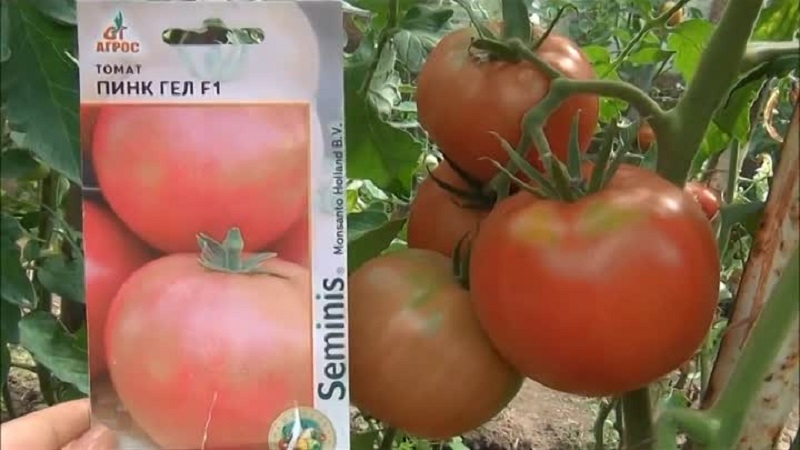
The table shows the distinctive features of the hybrid:
| Indicators | Characteristic |
| Weight | 200-250 g |
| The form | Flat-round, ribbed |
| Coloration | Raspberry |
| Leaves | Medium in size, light green in color |
| Inflorescence type | Plain |
| Number of cameras | More than six |
| Peduncle | Articulated |
| Pulp | Medium density |
| Taste | Sweet, pleasant, delicate |
| Skin | Dense, does not crack |
| Appointment | For fresh consumption, canning, making sauces, juice and pasta |
| Bushes height | 1.2-2 m |
| Ripening period | 76 days from the moment of landing in the ground |
| Yield | 12 kg / m² |
| Sustainability | To viral diseases |
| Transportability | High |

Pros and cons
The main advantages of pink gel tomatoes:
- short growing season;
- high productivity;
- the possibility of ripening outside the bush;
- resistance to cracking, verticillosis, fusarium, alternaria stem cancer, gray spot and sunburn;
- high content of sucrose and beta-carotene.
disadvantages - the need to tie bushes and pinch.
Other varieties of pink tomatoes:
Early maturing, undersized, pink variety "Pink Bush f1"
Growing seedlings
Tomatoes are grown through seedlings without picking sprouts... Seedlings form a strong root system without stress when planting in separate containers. We will tell you how to do this further.
Soil preparation and sowing seeds
For growing seedlings use a versatile light and nutritious soil from gardening shops. The soil can be prepared independently from black soil, peat, chicken droppings and sand, and ignited in the oven or poured with a dark pink solution of potassium permanganate.
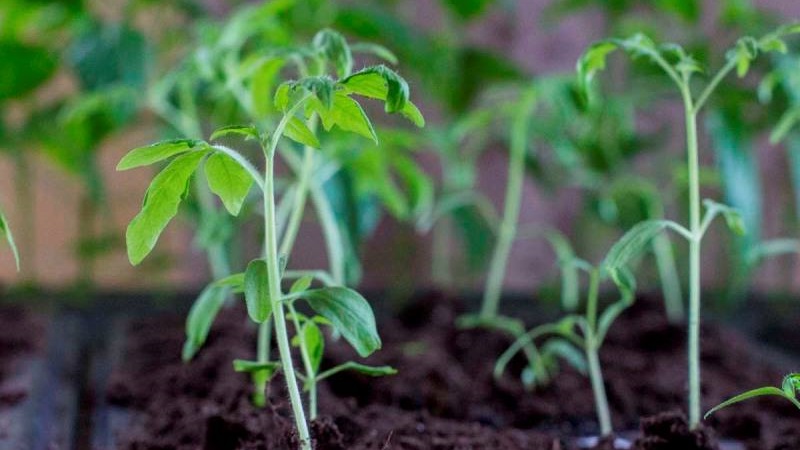
Sowing begins at the end of February, 60 days before planting in the ground.
For planting seeds, use special dense bags for seedlings or tall plastic cups. The containers are filled with soil, a 2 cm depression is made and 2 seeds are laid out. The soil is poured on top with a layer of 1 cm and moistened. Stretch the plastic wrap and put it in a dark place.
After germination the film is removed and the seedlings are taken out to a well-lit place. Observing the sprouts, the strongest sprout is determined, the weakest sprout is removed.
As the seedlings grow in the container, they add a layer of soil and moisten... This is done several times before planting seedlings in a greenhouse or vegetable garden. In just a few days, the root system will master a new layer of earth and become even stronger.
Planting seedlings and further care
Seedlings are planted in the first decade of May... Form holes 10 cm deep, fill them with boiling water or a strong solution of potassium permanganate for disinfection. The distance between plants is 60 cm, between rows - 90 cm. No more than three bushes are planted per 1 m². The beds are mulched with sawdust or peat.
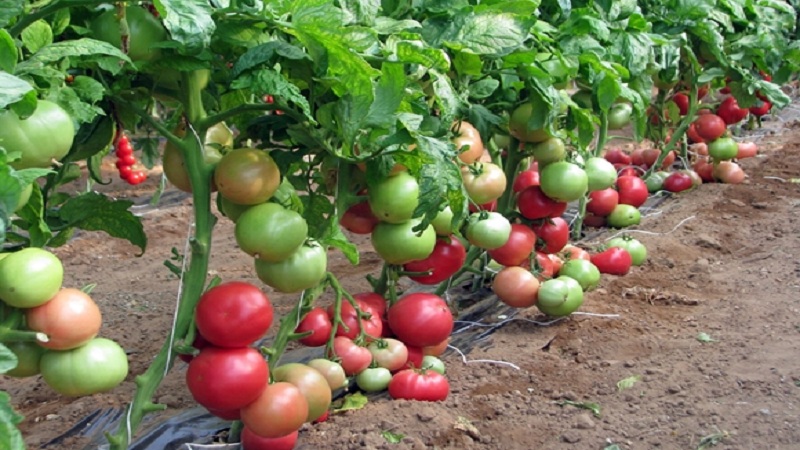
When planting in a greenhouse, the room must be ventilated, and air humidity at 70%. Daytime temperature +20 ° С, at night + 18 ° С.
Plant care provides:
- removal of damaged leaves;
- pruning abundantly flowering brushes (leave 5-6 inflorescences);
- the formation of a bush in 1-2 stems and a garter;
- launching bumblebees into the greenhouse for pollination, for this the vents are kept constantly open;
- installation of drip irrigation;
- application of foliar fertilizers.
Foliar dressing options for 10 liters:
- 1 tbsp. l. nitrophoski 14 days after planting in the ground;
- 50 g of wood ash, 30 g of superphosphate 14 days after the first feeding;
- 1 st. l. nitrophosphate, 1 tsp. sodium humate during fruiting (consumption 5 liters per 1 m²).
Tomatoes are preferably harvested at the stage of technical maturity.when the color turns brown. The fruits are placed in special polystyrene boxes and left to ripen. Tomatoes remaining on the bushes will ripen faster.
Prevention of diseases and pests
Pink Gel Hybrid is resistant to verticilliasis, fusarium, alternaria stem cancer, gray spot. But when grown in greenhouse conditions, there is a high probability of infection with late blight. The disease manifests itself as brown spots on the leaves, stems and fruits. A white bloom forms on the back of the leaves. This happens in case of excessive humidity in the room, overflow of soil and an excess of nitrogen.
Prevention methods late blight:
- In autumn, greenhouses are treated with sulfur bombs.
- The soil is disinfected with boiling water, chemicals (bleach, copper sulfate), biological products ("Gaupsin", "Trichodermin", "Fitosporin").
- After planting the bushes, the soil is mulched with sawdust, peat, needles.
- The humidity in the greenhouse is maintained at 70%.
- The top layer of the earth is renewed annually.
Drugs help get rid of phytophthora Fitosporin, "Thanos", "Radomil Gold", "Revus", "Profit Gold", "Quadris". 2-3 weeks before picking tomatoes, processing is stopped.
Green shoots, foliage, and fruit are favorite foods for aphids, spider mites, whiteflies, and slugs. Modern insecticides will come to the rescue in pest control and proven folk methods.
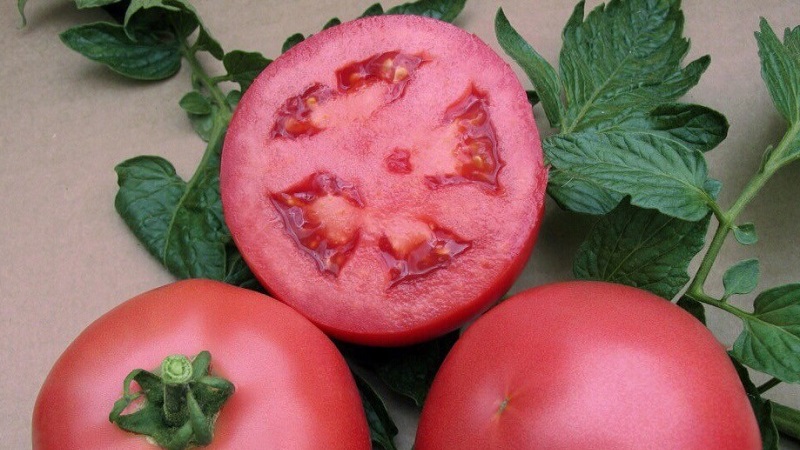
Slugs are harvested by hand at night under the light of lanterns or spray the bushes with a solution of ammonia (4 tablespoons of ammonia per 10 liters of water). Processing is carried out every three days for two weeks.
For spider mites and whiteflies use:
- insecticides "Borneo", "Flumite";
- biological products "Fitoverm", "Akarin";
- infusion of garlic (400 g of raw materials are crushed and poured into 1 liter of warm water, insisted for five days);
- infusion of tobacco (500 g of makhorka is poured into 10 liters of boiling water, insisted for 48 hours).
The following drugs have a lethal effect on aphids: "Iskra", "Biotlin", "Commander". Folk remedies are no less effective:
- Soap solution (100 g of laundry soap is grated and added to 10 liters of water). Young seedlings are treated with a sponge. Strong bushes are sprayed with a sprayer. Treatment frequency is every 2-3 days.
- Infusion of celandine (a bunch of grass is crushed and poured into 5 liters of warm water, after a day it is filtered and the volume is brought to 10 liters). Processing is carried out once every 7-10 days. The plant secretes poisonous sap, so all work is carried out with gloves. The knife and container are washed with soapy water and rinsed under the tap.
Are planted next to the tomatoes marigolds, fragrant dill, mustard to attract ladybirds - excellent helpers in the fight against aphids.
Reference. The methods of fighting bacteria and insects when growing tomatoes in open ground and in greenhouses are no different.
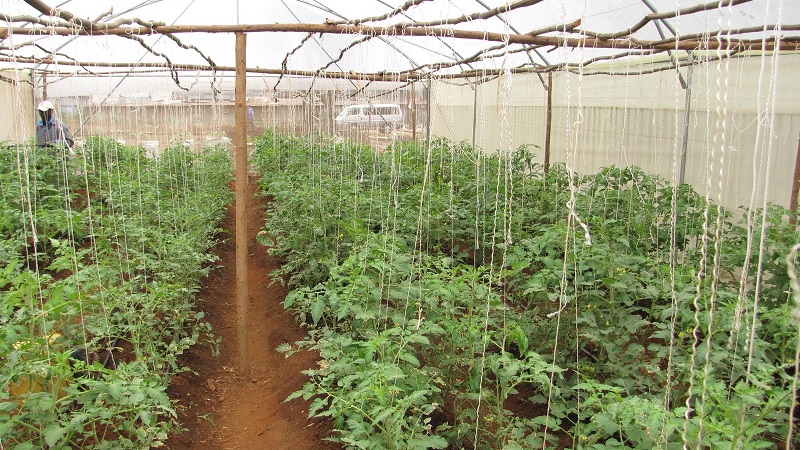
Features of growing indoors
In addition to the traditional method of growing tomatoes in greenhouses, use highly productive Dutch technology:
- The substrate is used at the initial stage - when growing seedlings.
- The picking of sprouts is carried out in containers filled with mineral wool, in which they will develop.
- Mineral wool is saturated with a solution with a nutritious mineral complex (nitrogen, potassium, phosphorus, calcium, magnesium), which is necessary for the growth of green mass, the formation of ovaries and fruits.
- Special equipment is installed in the greenhouse to control the level of humidity, temperature, and increase the concentration of carbon dioxide to accelerate photosynthesis.
- Three days before disembarking the seedlings, the room is warmed up. The optimum soil temperature is +16 ° C.
- The soil is leveled and covered with plastic wrap to prevent the growth of weeds and ensure light reflection.
- Glass greenhouses are thoroughly washed and disinfected. The soil is disinfected and the wells are prepared.
- Check the heating, irrigation and ventilation system.
- The leaves are regularly inspected for damage and the loose leaves are immediately removed.
- Abundantly flowering brushes are cut off, no more than six are left, so that the plant does not waste energy on the formation of a large number of ovaries, otherwise the fruits will be small.
- To pollinate plants, hornets and bumblebees are launched into the greenhouse during the flowering period.
- 10 days before the last harvest, the bushes are sprayed with ethylene to accelerate fruit ripening.
The nuances of planting seedlings in the ground:
- Containers with seedlings are placed in the holes so that their upper part rises above the surface by 2–2.5 cm. This will protect the stem from direct contact with the ground.
- The optimal gap between bushes is 70 cm, between rows - 90 cm.
- Seedlings are watered at the root or a drip irrigation system is installed.
Important! All work is carried out according to the schedule, strictly adhering to the technology. This method is best for growing large quantities of tomatoes for sale.
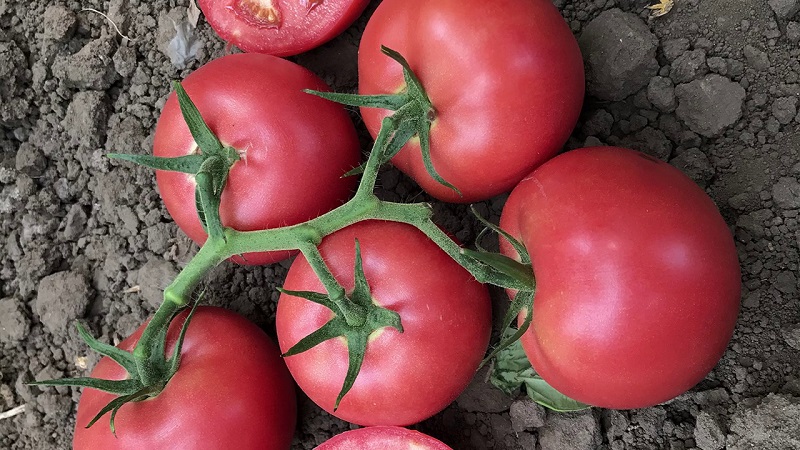
The nuances of outdoor cultivation
Pink gel hybrid is suitable for outdoor cultivation... The soil for planting is prepared in the fall: it is dug up and fertilized with manure (5 kg per 1 m²). In the spring, the soil is re-dug up and top dressing is applied: 1 tbsp is added to 5 kg of manure. l. potassium chloride, 5 tbsp. l. superphosphate.
Sowing seeds for seedlings begins 60-75 days before planting in the ground... The seedlings are transferred to a permanent place after warm weather sets in, the threat of frost disappears, and the soil warms up to a temperature of +16 ° C. The timing depends on the region: in the southern regions, seedlings are planted in early May, in the northern ones in early June.
Before planting seedlings are irrigated with copper chloride (30 g of substance per 10 l of water) for the prevention of bacterial lesions. Pits for indeterminate bushes are dug 15x15 cm in size with a depth of 10-15 cm. The planting pattern is checkerboard. Tall bushes are formed into 1-2 stems and tied to long supports.
The soil is mulched with sawdust, with hay or coniferous needles, 5 cm layer. Further care of tomatoes corresponds to the principles of growing indoors.
Reviews
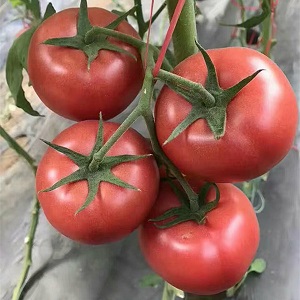 Gardeners who grow tomatoes for their own needs and for sale leave positive feedback on the Pink Gel hybrid:
Gardeners who grow tomatoes for their own needs and for sale leave positive feedback on the Pink Gel hybrid:
Valentina, Smolensk: “Pink gel hybrid has excellent yield and resistance to viral diseases, for which I love it. Tomatoes are medium in size, with a firm but not hard skin. The pulp is sweet and aromatic ".
Igor, Yartsevo: “I have been growing Pink Gel tomatoes in a greenhouse for several years in a row. The culture is unpretentious in care, loves moderate watering, rarely gets sick. We eat tomatoes fresh, pickle, prepare sauces ".
Ekaterina, Korostyn: “Excellent Dutch hybrid for greenhouse cultivation. It gives a high yield every time. I add top dressing three times during the entire growing season. I organized drip irrigation in the greenhouse and maintain the optimum humidity level. I have never experienced any special problems with growing ".
Conclusion
The Dutch tomato Pink girl f1 is suitable for cultivation in gardens and greenhouses, but like all hybrids, it shows the best results in greenhouses. For growing in large volumes, Dutch technology is used.The seedlings are dived into containers with mineral wool, saturated with a nutrient complex, and then transferred to greenhouses.
The culture does not require special care, it only needs moderate watering and the introduction of potassium-phosphorus fertilizers. The use of insecticides ("Flumite"), biological products ("Fitoverm") and folk remedies based on tobacco, garlic, celandine and soap solution help to quickly get rid of late blight and insect pests.